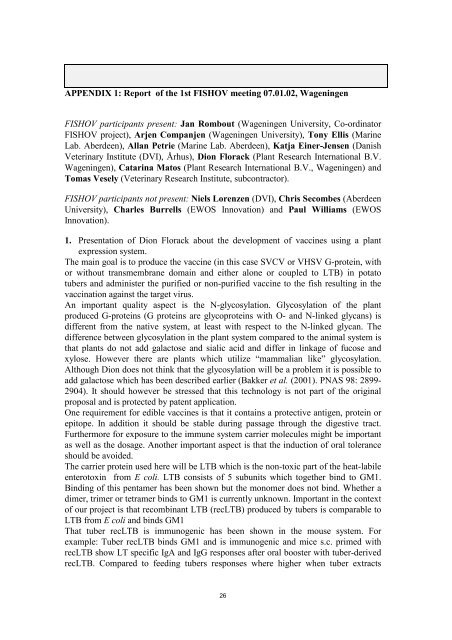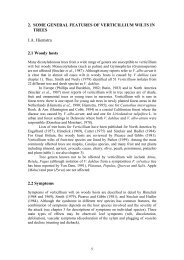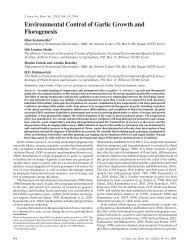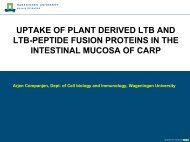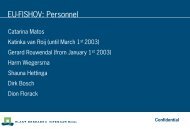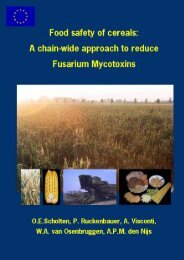CONFIDENTIAL REPORT - Plant Research International
CONFIDENTIAL REPORT - Plant Research International
CONFIDENTIAL REPORT - Plant Research International
- No tags were found...
Create successful ePaper yourself
Turn your PDF publications into a flip-book with our unique Google optimized e-Paper software.
APPENDIX 1: Report of the 1st FISHOV meeting 07.01.02, WageningenFISHOV participants present: Jan Rombout (Wageningen University, Co-ordinatorFISHOV project), Arjen Companjen (Wageningen University), Tony Ellis (MarineLab. Aberdeen), Allan Petrie (Marine Lab. Aberdeen), Katja Einer-Jensen (DanishVeterinary Institute (DVI), Århus), Dion Florack (<strong>Plant</strong> <strong>Research</strong> <strong>International</strong> B.V.Wageningen), Catarina Matos (<strong>Plant</strong> <strong>Research</strong> <strong>International</strong> B.V., Wageningen) andTomas Vesely (Veterinary <strong>Research</strong> Institute, subcontractor).FISHOV participants not present: Niels Lorenzen (DVI), Chris Secombes (AberdeenUniversity), Charles Burrells (EWOS Innovation) and Paul Williams (EWOSInnovation).1. Presentation of Dion Florack about the development of vaccines using a plantexpression system.The main goal is to produce the vaccine (in this case SVCV or VHSV G-protein, withor without transmembrane domain and either alone or coupled to LTB) in potatotubers and administer the purified or non-purified vaccine to the fish resulting in thevaccination against the target virus.An important quality aspect is the N-glycosylation. Glycosylation of the plantproduced G-proteins (G proteins are glycoproteins with O- and N-linked glycans) isdifferent from the native system, at least with respect to the N-linked glycan. Thedifference between glycosylation in the plant system compared to the animal system isthat plants do not add galactose and sialic acid and differ in linkage of fucose andxylose. However there are plants which utilize “mammalian like” glycosylation.Although Dion does not think that the glycosylation will be a problem it is possible toadd galactose which has been described earlier (Bakker et al. (2001). PNAS 98: 2899-2904). It should however be stressed that this technology is not part of the originalproposal and is protected by patent application.One requirement for edible vaccines is that it contains a protective antigen, protein orepitope. In addition it should be stable during passage through the digestive tract.Furthermore for exposure to the immune system carrier molecules might be importantas well as the dosage. Another important aspect is that the induction of oral toleranceshould be avoided.The carrier protein used here will be LTB which is the non-toxic part of the heat-labileenterotoxin from E coli. LTB consists of 5 subunits which together bind to GM1.Binding of this pentamer has been shown but the monomer does not bind. Whether adimer, trimer or tetramer binds to GM1 is currently unknown. Important in the contextof our project is that recombinant LTB (recLTB) produced by tubers is comparable toLTB from E coli and binds GM1That tuber recLTB is immunogenic has been shown in the mouse system. Forexample: Tuber recLTB binds GM1 and is immunogenic and mice s.c. primed withrecLTB show LT specific IgA and IgG responses after oral booster with tuber-derivedrecLTB. Compared to feeding tubers responses where higher when tuber extracts26


